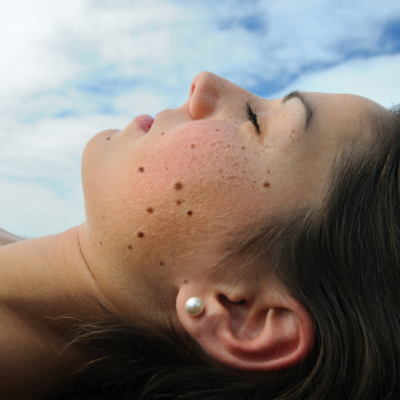
When Is A Zit Not A Zit? And Why You Shouldn’t Mess With It
Reviewed By Gregory Henderson, MD
You look in the mirror and see something on your face. A zit. A pimple. A blemish. A spot. Whatever you call it, you want it gone. Now. But wait. Please don’t touch it.
Although a blemish on your face might look like a whitehead or reddened pimple, it could very well be something else. Something more serious. Attempting to pop it could cause whatever it is to rupture and spread. Or to scar over and possibly regrow. Then you’d have a scar and a blemish.
Possibilities of that zit’s real identity include milia, seborrheic keratosis, warts or even basal cell carcinoma, a type of skin cancer.
Only a dermatologist can diagnose what it really might be and determine the most medically effective way to get rid of it based on your medical history, skin type and other factors.
Milia: Tiny but Tricky
Milia are tricky because what often can cause them – a moisturizer too heavy for your skin – can also cause their dupe – a whitehead. But instead of clogged sebum, milia results from a skin protein called keratin getting trapped beneath the skin’s surface. Unlike acne, bacteria or blocked pores don’t cause milia, and they don’t become inflamed. The little whitish-yellowish bump will appear smaller and feel harder than a typical whitehead.
Treatment Options:
Although it is tempting to squeeze, forget it. Milia won’t pop like a pimple because they’re encased in a layer of skin. Squeezing can damage the surrounding skin and lead to scarring. Your CSI dermatologist can safely remove milia with sterile tools, often using a small incision or laser treatment to extract them without trauma to the skin. Along with recommendations for what types of skin care products to use and to avoid, your dermatologist may also prescribe a topical retinoid to prevent new milia from forming.
Seborrheic Keratosis: Master of Disguise
Depending on where on the face it appears and its coloration and texture, seborrheic keratosis can look like several other skin conditions. If it’s a fleshy bump, it can look like a wart; if it has a raised, rough texture and varied colors (from brown to black), it can be mistaken for skin cancer. If it’s small, reddened and round, it can look like a pimple. But it’s a benign but stubborn growth whose cause is not well known. Genetics and cumulative sun exposure may be factors.
Treatment Options:
Despite hearsay about lemon juice and apple cider vinegar, there are no home remedies for seborrheic keratosis. DIY removal attempts can cause bleeding, infection, and scarring. The only safe methods to remove these growths are in the dermatologist’s office, including cryotherapy (freezing), electrosurgery (burning off with an electric current), and laser therapy. Treatment is usually painless, with little recovery time, and effectively removes the growth without causing damage to the surrounding skin.
Warts: Viral Visitors
A type of wart referred to as a flat wart is a small pink or brown bump that may appear on the face. Some have a smooth, flesh-colored appearance making them easy to mistake for pimples. Warts can be contagious and spread by touch, especially if picked at. Although different from the rough raised warts that often appear on fingers, the cause is the same. Human papilloma virus. You might think HPV is an STD. It is. But there also are many other strains of HPV; over one hundred in fact. They are highly contagious and can spread through casual contact or even through an object recently handled by someone with HPV. Estimates indicate that nearly everyone gets non-genital HPV at some point in their lives. Most people have no symptoms and may unknowingly transmit it.
Treatment Options:
Squeezing or picking a wart will not only fail to get rid of it but may spread it to nearby areas. Dermatologists have several effective treatments for warts, including cryotherapy, lasers, and prescription strength topical salicylic acid preparations. For stubborn or deep warts, immunotherapy or other specialized treatments may be necessary. Since warts can look like other skin conditions, a dermatologist’s assessment is crucial for accurate diagnosis and treatment.
Basal Cell Carcinoma: The Dangerous Dupe
Basal cell carcinoma (BCC) is the most common form of skin cancer, often appearing as a translucent or pearly bump. Unlike a zit, BCC doesn’t go away on its own and may bleed, ooze, or crust over repeatedly. Although it rarely spreads, it can grow into deeper layers of the skin and even bones if left untreated. Many people mistake it for a zit, especially when it first appears as a small, flesh-colored bump.
Treatment Options:
Treatment options vary depending on the size, depth, and location of the carcinoma. Dermatologists may use techniques such as Mohs surgery (where thin layers of cancerous skin are removed and examined until no abnormal cells remain), cryotherapy, laser therapy, or for growths caught early, excision removal or a prescription topical treatment.
Don’t Try This at Home
If you’ve got a zit or a growth that isn’t going away or changes in size, shape, or color, it’s time to book an appointment with your CSI dermatologist.
Amateur attempts to treat or remove a growth caused by any of the above conditions could lead to scarring, infection, and spread of the underlying issue. Your CSI dermatologist can accurately identify and treat that skin spot, ensuring your skin stays healthy and looks its best.



 / 291 Reviews
/ 291 Reviews